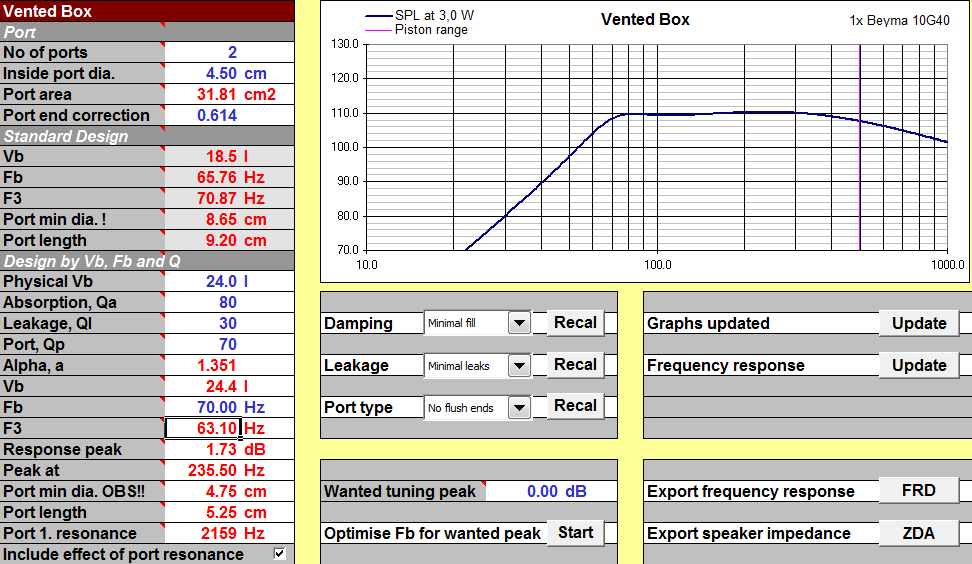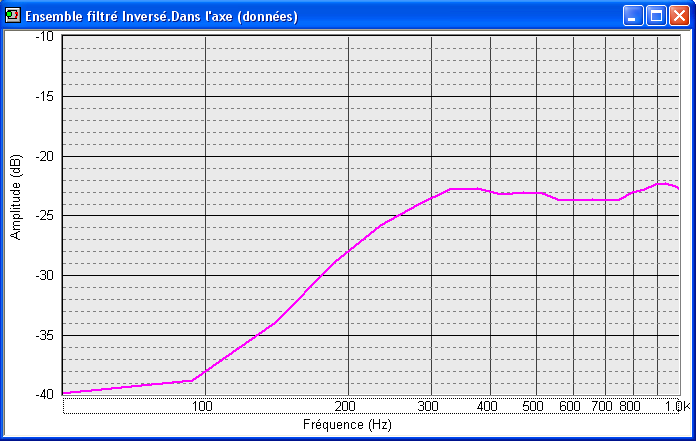For this project I would like my mains based on Beyma 10G40 and B&C DE250 to go down to 80Hz at least where the sub will take over...
The Beyma in my box (30l net, 24l "actual") seems well able to achieve this (in all softawre I used).
Here is what UniBox predicts...

Unfortunately, I cannot get them to go as low as this.
Here is what measures tell (this is all filtered with both drivers, but I have removed response over 1K to show the thing).

I first questioned my measurement set up, but using different method changes nothing.
I am using a Panasonic mic (WM-61A) and a "Wallin" preamp (2).
I used SpeakerWorkshop, CollEdit + Aurora and REW as well and they all tell teh same...
Bass drops as early as 330Hz and more than 3dB are lost before crossing 200Hz.
Anything obvious is wrong ?
I must say that I do not know what to explore and feel out of options...
Please help me getting teh bass I deserve (according to Unibox and WinISD) .
.
Many thanks in advance.
The Beyma in my box (30l net, 24l "actual") seems well able to achieve this (in all softawre I used).
Here is what UniBox predicts...

Unfortunately, I cannot get them to go as low as this.
Here is what measures tell (this is all filtered with both drivers, but I have removed response over 1K to show the thing).
I first questioned my measurement set up, but using different method changes nothing.
I am using a Panasonic mic (WM-61A) and a "Wallin" preamp (2).
I used SpeakerWorkshop, CollEdit + Aurora and REW as well and they all tell teh same...
Bass drops as early as 330Hz and more than 3dB are lost before crossing 200Hz.
Anything obvious is wrong ?
I must say that I do not know what to explore and feel out of options...
Please help me getting teh bass I deserve (according to Unibox and WinISD)
Many thanks in advance.
Hi,
Seems you might have run into the baffle step chestnut .....
(though this depends how you are measuring them).
Only lower than usual due to your large baffle width.
It causes a 6dB step in the response freefield. It can be seen
on a lot of Seas bass/mid plots, for drivers measured in boxes.
Here is a classic example of 6dB baffle step for a driver that
would measure near flat into half space (very large baffle) :
http://www.seas.no/images/stories/vintage/pdfdataheet/h0419_p17re.pdf
~150Hz to ~750 Hz is the box baffle step.
 /sreten.
/sreten.
Seems you might have run into the baffle step chestnut .....
(though this depends how you are measuring them).
Only lower than usual due to your large baffle width.
It causes a 6dB step in the response freefield. It can be seen
on a lot of Seas bass/mid plots, for drivers measured in boxes.
Here is a classic example of 6dB baffle step for a driver that
would measure near flat into half space (very large baffle) :
http://www.seas.no/images/stories/vintage/pdfdataheet/h0419_p17re.pdf
~150Hz to ~750 Hz is the box baffle step.
I have experimented a bit more tonight and it would seem that the question is more : How do you measure bass ?
I have measure my current driver (do not remember the spec, but they *do* bass when listening)... the curve from 300Hz does look exactly the same in SW...
I tried to put the mic firther away (was using 1 meter) and I had to change the measurement window in SW...
Guess what ?
It changes the roll off point as well (starts even higher now).
How do you guys do to measure bass (I mean below 300Hz) ?
I have measure my current driver (do not remember the spec, but they *do* bass when listening)... the curve from 300Hz does look exactly the same in SW...
I tried to put the mic firther away (was using 1 meter) and I had to change the measurement window in SW...
Guess what ?
It changes the roll off point as well (starts even higher now).
How do you guys do to measure bass (I mean below 300Hz) ?
sreten said:Hi,
Seems you might have run into the baffle step chestnut .....
(though this depends how you are measuring them).
Only lower than usual due to your large baffle width.
It causes a 6dB step in the response freefield. It can be seen
on a lot of Seas bass/mid plots, for drivers measured in boxes.
Here is a classic example of 6dB baffle step for a driver that
would measure near flat into half space (very large baffle) :
http://www.seas.no/images/stories/vintage/pdfdataheet/h0419_p17re.pdf
~150Hz to ~750 Hz is the box baffle step.
/sreten.
Hi, it could well be that, but I am rather leaning towards a measurement problem.
The loudspeaker I measured tonight has very different baffle size and shows the same strange roll off.
I think this "gated" method in SW does no good for bass.
sreten said:Hi,
Gated ? Gated measurements have a roll-off related to the window.
/sreten.
This is what I figured out... I remember reading gated measurement were not accurate below 200Hz, but 1)I did not really register, 2)I did not think it would have such an impact.
What would you use (freeware/open source) to do a not gated measure ? Still Speaker Workshop ?
G'day Jean-Michel
You can gate your measurement, but keep the time >1sec and you shouldn't run into any problems.
Alternatively use a SPL meter and 1/6th octave test tones, near field. The analogue RS meter with Wallin mod or with correction curves works very well for the $$$. This will give you a good idea of your LF response.
Cheers
William Cowan
You can gate your measurement, but keep the time >1sec and you shouldn't run into any problems.
Alternatively use a SPL meter and 1/6th octave test tones, near field. The analogue RS meter with Wallin mod or with correction curves works very well for the $$$. This will give you a good idea of your LF response.
Cheers
William Cowan
cowanaudio said:G'day Jean-Michel
You can gate your measurement, but keep the time >1sec and you shouldn't run into any problems.
Ouch!!! Indeed, I am using 12ms, that's a big difference!!!
cowanaudio said:
Alternatively use a SPL meter and 1/6th octave test tones, near field. The analogue RS meter with Wallin mod or with correction curves works very well for the $$$. This will give you a good idea of your LF response.
Cheers
William Cowan
Could do this as well indeed...
I might give a try to SynRTA as well (or equivalent), not a big investment and it might well be good enough for the below 300Hz range.
Thanks for your advices guys,
- Status
- This old topic is closed. If you want to reopen this topic, contact a moderator using the "Report Post" button.
- Home
- Loudspeakers
- Multi-Way
- Help me getting the bass I simulated (Beyma 10G40 in vented box)